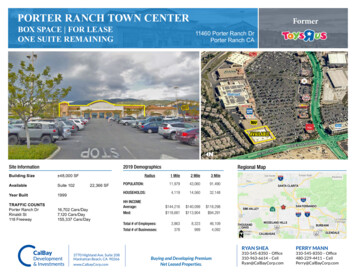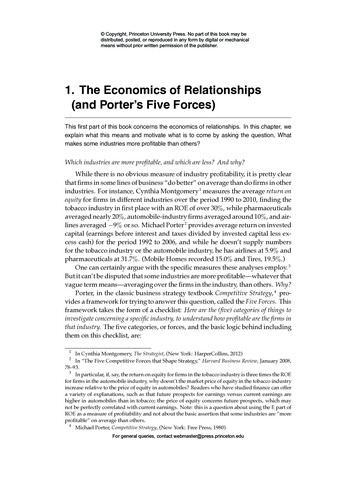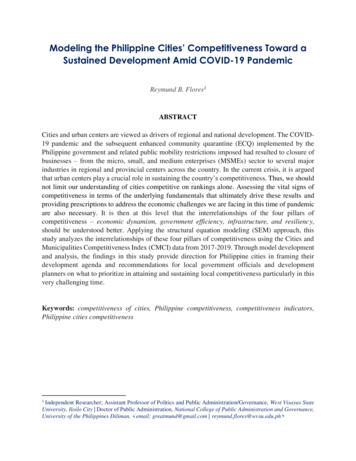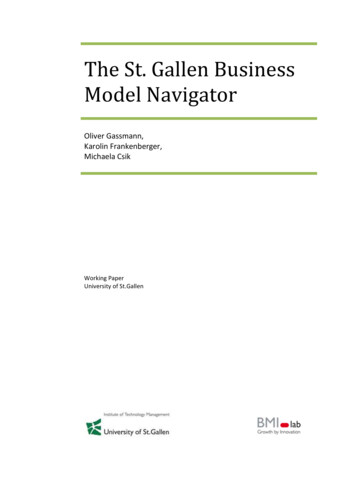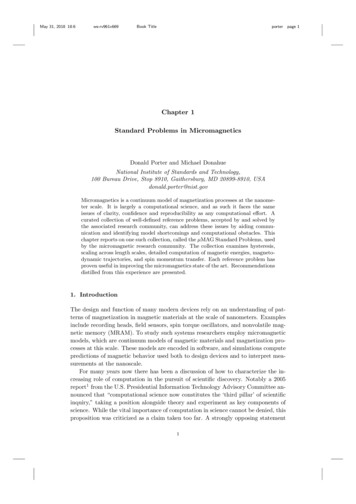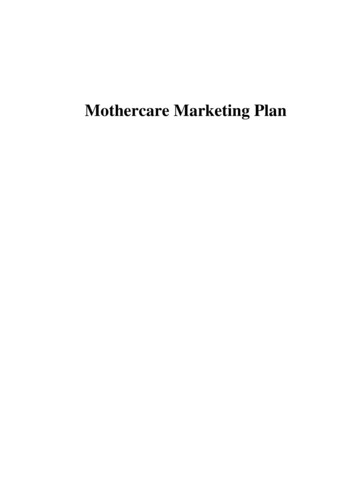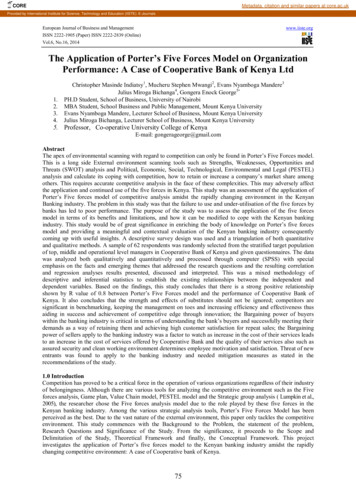
Transcription
COREMetadata, citation and similar papers at core.ac.ukProvided by International Institute for Science, Technology and Education (IISTE): E-JournalsEuropean Journal of Business and ManagementISSN 2222-1905 (Paper) ISSN 2222-2839 (Online)Vol.6, No.16, 2014www.iiste.orgThe Application of Porter’s Five Forces Model on OrganizationPerformance: A Case of Cooperative Bank of Kenya Ltd1.2.3.4.Christopher Masinde Indiatsy1, Mucheru Stephen Mwangi2, Evans Nyamboga Mandere3*Julius Miroga Bichanga4, Gongera Enock George5PH.D Student, School of Business, University of NairobiMBA Student, School Business and Public Management, Mount Kenya UniversityEvans Nyamboga Mandere, Lecturer School of Business, Mount Kenya UniversityJulius Miroga Bichanga, Lecturer School of Business, Mount Kenya University5. Professor, Co-operative University College of KenyaE-mail: gongerageorge@gmail.comAbstractThe apex of environmental scanning with regard to competition can only be found in Porter’s Five Forces model.This is a long side External environment scanning tools such as Strengths, Weaknesses, Opportunities andThreats (SWOT) analysis and Political, Economic, Social, Technological, Environmental and Legal (PESTEL)analysis and calculate its coping with competition, how to retain or increase a company’s market share amongothers. This requires accurate competitive analysis in the face of these complexities. This may adversely affectthe application and continued use of the five forces in Kenya. This study was an assessment of the application ofPorter’s Five forces model of competitive analysis amidst the rapidly changing environment in the KenyanBanking industry. The problem in this study was that the failure to use and under-utilisation of the five forces bybanks has led to poor performance. The purpose of the study was to assess the application of the five forcesmodel in terms of its benefits and limitations, and how it can be modified to cope with the Kenyan bankingindustry. This study would be of great significance in enriching the body of knowledge on Porter’s five forcesmodel and providing a meaningful and contextual evaluation of the Kenyan banking industry consequentlycoming up with useful insights. A descriptive survey design was used and a triangulation of both quantitativeand qualitative methods. A sample of 62 respondents was randomly selected from the stratified target populationof top, middle and operational level managers in Cooperative Bank of Kenya and given questionnaires. The datawas analyzed both qualitatively and quantitatively and processed through computer (SPSS) with specialemphasis on the facts and emerging themes that addressed the research questions and the resulting correlationand regression analyses results presented, discussed and interpreted. This was a mixed methodology ofdescriptive and inferential statistics to establish the existing relationships between the independent anddependent variables. Based on the findings, this study concludes that there is a strong positive relationshipshown by R value of 0.8 between Porter’s Five Forces model and the performance of Cooperative Bank ofKenya. It also concludes that the strength and effects of substitutes should not be ignored; competitors aresignificant in benchmarking, keeping the management on toes and increasing efficiency and effectiveness thusaiding in success and achievement of competitive edge through innovation; the Bargaining power of buyerswithin the banking industry is critical in terms of understanding the bank’s buyers and successfully meeting theirdemands as a way of retaining them and achieving high customer satisfaction for repeat sales; the Bargainingpower of sellers apply to the banking industry was a factor to watch as increase in the cost of their services leadsto an increase in the cost of services offered by Cooperative Bank and the quality of their services also such asassured security and clean working environment determines employee motivation and satisfaction. Threat of newentrants was found to apply to the banking industry and needed mitigation measures as stated in therecommendations of the study.1.0 IntroductionCompetition has proved to be a critical force in the operation of various organizations regardless of their industryof belongingness. Although there are various tools for analyzing the competitive environment such as the Fiveforces analysis, Game plan, Value Chain model, PESTEL model and the Strategic group analysis ( Lumpkin et al.,2005), the researcher chose the Five forces analysis model due to the role played by these five forces in theKenyan banking industry. Among the various strategic analysis tools, Porter’s Five Forces Model has beenperceived as the best. Due to the vast nature of the external environment, this paper only tackles the competitiveenvironment. This study commences with the Background to the Problem, the statement of the problem,Research Questions and Significance of the Study. From the significance, it proceeds to the Scope andDelimitation of the Study, Theoretical Framework and finally, the Conceptual Framework. This projectinvestigates the application of Porter’s five forces model to the Kenyan banking industry amidst the rapidlychanging competitive environment: A case of Cooperative bank of Kenya.75
European Journal of Business and ManagementISSN 2222-1905 (Paper) ISSN 2222-2839 (Online)Vol.6, No.16, 2014www.iiste.org1.1 Background to the ProblemGlobally, the use of Porter’s Five Forces model involves a continuous process of environmental scanning andmonitoring as well as obtaining competitive intelligence on present and potential rival banks. This is why many banksuse scenario planning to anticipate and respond to volatile and disruptive environmental changes. Strategic managementidentifies the general environment and the competitive environment (Dess, et al., 2005).Although many scholars and practitioners at both the international and local levels still highly value and use Porter’s Fiveforces model, there has been a high level of debate on the application of this model to the complex contemporary industryenvironment with rapid changes and technological advancement. Some scholars argue that the advance of internet hasdone much in changing the industry environment and thus challenging the five forces model. They argue thatbefore the advent of the internet, every industry consisted of a physical part and an informational set and theinformational set was difficult to handle and access. This makes them to further point that Porter’s argument thatin as much as the five underlying forces of competition determine the industry attractiveness, it has also beenchallenged by its failure to explain the expansion of the distance learning industry (Karagiannopoulos et al.,2005).Other scholars have also criticized the static nature of the model as a challenge to innovation in a rapidlychanging industrial structure such as environmental trend or event, such as changes in the ethnic composition of apopulation or a technological innovation which may pose a greater impact on some industries than on others (Dess, et al.,2005). It was rightly noted that another critical point that the model ignores the pivotal role of complements byfocusing on industry and group structures rather than individual companies (Brandenburger & Nalebuff, 1995).The shift towards the internet consequently impacts on the Five competitive forces and influence the Industrystructure rather than porter’s argument that industry structure is not fixed but rather is shaped to a considerabledegree by the choices made by competitors. It is also argued that companies can still capture a lot of benefits andat the same time reduce the buyers bargaining power which implies that Porter’s Five forces model may stillremain relevant (Kosiur, 1997).A survey carried out in the late 1980s revealed that only a few of the influences Porter flagged commandedstrong empirical support. They assert that despite the fact that the “five forces” framework focuses on businessconcerns rather than public policy, it also emphasizes extended competition for value rather than justcompetition among existing rivals, and the simplicity of its application inspired numerous companies as well asbusiness schools to adopt its use (Wheelen & Hungerl, 2000). These factors of the static nature of the five forcesmodel, innovation, and lack of complements may impact on the application of the five forces model to theKenyan banking industry. This industry which is regulated by the Central Bank of Kenya is one of the profitableand fastest growing industries with increase in the number of both local and international financial players.Continentally, scholars have admitted the critical role of Porter’s five forces model in Botswana. Rivalry fromalready established firms, threat of new entrants, threat of substitute products, bargaining power of buyers andsellers are indomitable forces within the African continent and the world in general that any business cannotafford to ignore them (Monbiot, 2011).In Kenya, some scholars have highly praised the model as applicable to highly competitive environments whileadding other forces such as technology, complementors and other PESTEL factors to the model (Aosa, 2009).This confirms the position of different scholars but falls short of clarifying whether the model is applicable ornot to the Kenyan banking industry. He argues that the mere coming up with more forces that can be added tothe model is a development in itself, but this does not render the five forces stated by Porter to be redundant orirrelevant. All theories should be open to development based on further research and time.In a study on the Relevance of the Five Forces Model to the Kenyan Mobile telephony Industry, it was noted thatthe Five Forces are forces to reckon within the Kenyan mobile telephony environment but also followed asimilar pattern in citing additional forces but arranged them in different layers such as the foundational forcesand other forces (Okoreh, 2010).1.1.1 The Kenyan Banking IndustryThe Kenyan Banking industry has 43 commercial banks with some operating as local and others as internationalbanks. Their services fall under various categories such as deposit taking, provision of loan facilities,transactions, e-services among others based on their individual competencies. The Kenyan banking sector hasincreased uptake of customer credit history by banks and additional approvals to banks to commence agencybanking in this highly profitable industry (Anyanzwa, 2013). The competitive forces in the industry haveincreased owing to the continued entry of international banks in the Kenyan market (Olaka, 2013). This growingcompetition from international as well as local banks may require a critical analysis of the competitive forces inthe industry.1.2 Statement of the ProblemCompetition related challenges have continuously increased globally and locally. This is what propelled scholarsto come up with strategic analysis tools to aid in appraising both the external and internal environment. The76
European Journal of Business and ManagementISSN 2222-1905 (Paper) ISSN 2222-2839 (Online)Vol.6, No.16, 2014www.iiste.orginternal environment has been perceived as fairly challenging because it is within the control of the organizationwhile the external environment on the other hand has been perceived as complex due to its being beyond thecontrol of the organization (Dess et al., 2005). Porter’s Five Forces Model has been highly praised for itsefficiency and effectiveness. Recent developments in research have however shown that some scholars arguethat the Five Forces Model cannot be applied to analyze competition right from its inception of the Five forces todate (Karagiannopoulos et al., 2005). This point towards a bleak future for the model and the banking industry inwhich there is intense competition and need for a thorough environmental audit that can help banks maintaincompetitive edge over their competitors. The problem in this study is that the failure to use and under-utilisationof the five forces by banks has led to poor performance. As a way of covering their poor performance, the bankssettled on high interest rates to make them retain their profitability. This poor performance and reverting to highinterest rates as a way of covering up for the dwindling market share, reduced sales, reduced profitability,increased costs of operation, efficiency and effectiveness-related challenges has led to outcries from buyers ofbanking services and withdrawal of some clients to Savings and Credit Cooperative Societies (SACCOS).2.0 LITERATURE REVIEW2.1 Review of Porter’s Five Forces ModelAlthough there are various tools for analyzing the competitive environment such as the Five forces analysis,Game plan, Value Chain model, PESTEL model and the Strategic group analysis (Porter, 1998), the researcherchose the Five forces analysis model due to the role played by these five forces in the Kenyan banking industry.Porter’s Five forces model of competitive analysis is an illustration of how the Five competitive forces can be used toexplain low profitability and viable entries to an industry (Hill & Jones, 2007).These Five forces are the threat of new entrants, buyer power, supplier power, threat of substitutes, and rivalry among thealready established firms. The intensity of these forces highly determines the average expected level of profitability in anindustry and their thorough understanding, both individually and in combination, is beneficial in deciding what industries toenter, and in assessing how a firm can improve its competitive position (McGanan.A.N,1997). The strength of each of thefive forces is inversely proportional to the price and profits such that a weak competitive force may serve as anopportunity, while a strong one, may serve as a threat (Hill & Jones, 2007).2.2 The risk of entry by new potential competitorsThreat of new entrants refers to the possibility that the profits of established banks in the industry may be eroded by newcompetitors. The extent of the threat depends on existing barriers to entry and the combined reactions from existingcompetitors. If entry barriers are high or the new-comer anticipates a sharp retaliation from established competitors (Porter,1998), threat of entry becomes low. The circumstances discourage new competitors. The major barriers to new entries aremany including patents and brand identification ( Bateman & Snell, 2004).2.3 The major barriers to new entrantsEconomies of Scale: Economies of scale refers to spreading the costs of production over the number of units produced.The cost of a product per unit declines as the absolute volume per period increases. This deters entry by forcing the entrant tocome in at large scale and risk strong reaction from existing banks or come in at a small scale and accept a costdisadvantage. Both are undesirable options. The Sources of Economies of Scale as cost production gained through massproducing a standardized output, discount on bulk purchases of inputs and component parts, the advantages of spreadingfixed production costs over a large production volume and the savings from spreading marketing and advertising costs over alarge volume of output. These factors deter potential small scale competitors by giving them a significant cost disadvantageand a high capital requirement in various ways (Hill & Jones, 2007).Product Differentiation is the strong brand identification, customer loyalty, and differentiation in established industrieswhich create a barrier to entry by forcing entrants to spend heavily to overcome existing customer loyalties. High capitalrequirements also create barrier to entry due to the need to invest large financial resources to compete or risky orunrecoverable advertising and research (Bateman & Snell, 2004). Another factor is the switching costs in cases where abarrier to entry is created by the existence of one-time costs that the buyer faces when switching from one supplier'sproduct or service to another.Access to Distribution Channels also deters the new entrants due to the need to secure a distribution channel for itsproducts. There are also cost disadvantages independent of size or economies of scale that bars new entrants. The alreadyestablished industries may have advantages independent of economies of scale through a proprietary product, favorableaccess to raw materials and government subsidies .The fewer the entry barriers, the higher the threat of new entrants. If a newfirm can launch its business with a low capital investment and operate efficiently despite its small scale of operation, it islikely to be a threat. It is dangerous for a firm to enter an industry with very low entry barriers (Bateman & Snell, 2004).2.4 Bargaining power of buyersBuyers may threaten an industry by forcing down prices, bargaining for higher quality or more services, and playingcompetitors against each other. This consequently reduces profitability. The power of each buyer group depends onthe attributes of the market situation and the importance of purchases from that group compared with the overallbusiness (Alkhafaji, 2003). Buyers of banking services are institutions, organized groups, Non Governmental77
European Journal of Business and ManagementISSN 2222-1905 (Paper) ISSN 2222-2839 (Online)Vol.6, No.16, 2014www.iiste.orgOrganizations, Faith Based Organizations, Community Based Organizations and individual clients2.5 Bargaining power of suppliersSuppliers can pressurize an industry by through price increments or quality reduction of the purchased products.Powerful suppliers can squeeze the profitability of banks industry so far that they can't recover the costs of rawmaterial inputs. They are companies that supply raw materials, equipment, machinery, associated services and labor.Suppliers of banks may included trade unions for the supply of labour force, Automated Vending Machine suppliers,cleaning services, IT consultants, marketing agents just to mention but a few (Dagmar, 2001).2.6 Conditions under which a supplier group can be powerfulThe supplier group is dominated by a few companies and is more concentrated few banks dominate the industry than theindustry it sells to. Suppliers selling from fragmented industries influence prices, quality, and terms. Another condition is ifthe supplier group is not obliged to contend with substitute products for sale to the industry. This is because the power ofeven large, powerful suppliers can be checked if they compete with substitutes (Alkhafaji, 2003).The third condition is ifthe industry is not an important customer of the supplier group. This occurs when suppliers sell to several industries and aparticular industry does not represent a significant fraction of its sales, suppliers are more prone to exert power. Supplierscan also be powerful if their product is an important input to the buyer's business. When such inputs are important to thesuccess of the buyer’s manufacturing process or product quality, the bargaining power of suppliers is high (Dess, et al.,2005)Another condition is that suppliers are powerful if the supplier group’s products are differentiated or it has built upswitching costs for the buyer as these two costs cut off their options of playing one supplier against another. Finally, thesupplier group can be powerful if it poses a credible threat of forward integration which provides a control measure againstthe industry’s ability to improve the terms of purchases (Riley, 2012).2.7 Threat of substitute productsAll banks within an industry compete with industries producing substitute products and services because substitutesreduce the potential returns of an industry by placing a ceiling on the prices that banks in that industry can profitably charge.Identifying substitute products involves searching for other products or services that can perform the same function as theindustry’s products (Riley, 2012). In the banking industry, substitutes have been noted to be the Savings and CreditSocieties with low levels of interest and less strict terms and conditions regarding their loan services. This is a delicaterole that leads a manager into businesses seemingly far removed from the industry such as digital technology, wirelessforms of telecommunication, teleconferencing, and e-commerce as viable substitutes for traveling.2.8 Rivalry among established firmsRivalry is the competitive struggle between banks in an industry to gain market share from each other (Hill & Jones, 2007). Itis jockeying for position whereby banks use tactics like price competition, advertising battles, product introductions,quality competition, and increased customer service or warranties (Pearce & Robinson, 1994). The competitor is the first tobe dealt with in competitive environment (Bateman & Snell, 2004).There are 43 banks that compete with Cooperative bank of Kenya in provision of similar services under the sameexternal environment. These include banks such as Kenya Commercial bank, Equity, National bank of Kenya, HabibBank, City Bank, Standard Chartered, Barclays Bank of Kenya, Family Bank among others.Rivalry occurs when competitors sense the pressure or act on an opportunity to improve their market segment (Dagmar,2005). Some forms of competition, such as price competition, are typically highly destabilizing and are critical forprofitability level in an industry. For example, price cutting lowers profits for all banks while advertising battles inflate thedemand and enhance the level of product differentiation for the benefit of all banks in the industry. The intensity of rivalrydiffers across industries and this may be due to various factors.2.9 Examples of Exit BarriersInvestment in expensive assets such as machines, equipment and operating facilities which need writing off their book value,high fixed costs of exit such as severance pay, health benefits and pensions in case of liquidation and emotional attachmentsto an industry such as sentiment or pride which prevent banks from leaving the industry. Other exit barriers include economicdependence on the industry because of failure to diversity in other industries, the need for maintaining an expensivecollection of assets for effective participation in the industry, and tough bankruptcy regulations (Hill & Jones, 2007).2.10 Porter’s Competitive StrategiesPorter identified the competitive, corporate and generic strategies that can be applied after successful competitive analysis. Healso outlined three general business level strategies that can be used to gain competitive advantage over other banks operatingin the same industry, that is, cost leadership and differentiation strategy for the broad industry-wide environment, and focusstrategy for the narrow market segments. The focus strategy consists of the low cost focus strategy and focus/nichedifferentiation strategy (Porter, 1980). Porter also identified the specific generic strategies for countering the fiveindustry forces.78
European Journal of Business and ManagementISSN 2222-1905 (Paper) ISSN 2222-2839 (Online)Vol.6, No.16, 2014www.iiste.orgTable 1 Porter’s Generic StrategiesIndustryForceGeneric StrategiesCost LeadershipDifferentiationFocusEntryBarriersAbility to cut price inCustomerloyaltycan Focusing develops core competencies thatretaliationdetersdiscourage potential entrants.can act as an entry barrier.potential entrants.BuyerPowerAbility to offer lower Large buyers have less power toLarge buyers have less power to negotiateprice to powerful negotiate because of few closebecause of few liers have power because of lowBetter insulated from Better able to pass on supplier volumes, but a differentiation-focusedpowerful suppliers.price increases to customers.firm is better able to pass on supplierprice increases.Can use low price to Customer's become attached toSpecialized products & core competencyThreat ofdefendagainst differentiatingattributes,protect against substitutes.Substitutessubstitutes.reducing threat of substitutes.RivalryBetter able to compete Brand loyalty to keep customers Rivals cannot meeton price.from rivals.focused customer needs.differentiation-Adapted from Porter (2003)In cost leadership strategy, a bank can decide to become the low cost producer in its industry by charging thelowest price or rates for its services (Porter, 1985). The sources of cost advantage for such a bank may includeeconomies of scale, proprietary technology, preferential access to raw materials and other factors. A low costproducer must find and exploit all sources of cost advantage as well as be in a position to be an above averageperformer in its industry to such an extent that it can command prices at or at least near the industry average. Byutilizing differentiation strategy, a bank can be unique in its industry or products in areas that are highly valuedby its clients. This may involve selecting one or more attributes that many buyers in the banking industryperceive as important, and then uniquely positions itself to meet those needs. This uniqueness is rewarded bycharging a premium price (Hamel .G.2002).A bank’s utilization of focus strategy implies its choice of narrowing of competitive scope within the bankingindustry. The focusing bank selects a segment or group of segments in the industry and tailors its strategy toserving them effectively and efficiently to the exclusion of others. Focus strategy may be cost focus ordifferentiation focus. In cost focus strategy, a bank seeks cost advantage in its target segment while indifferentiation focus; a bank seeks differentiation in its target segment (Thomson A.A 1990). Both variants of thefocus strategy rest on differences between a target segment and other segments. The target segments must eitherhave buyers with unusual needs or the production and delivery system that best serves the target segment mustdiffer from that of other segments. Cost focus exploits differences in cost behavior in some segments, whiledifferentiation focus exploits the special needs of buyers in certain segments.2.11 Theoretical FrameworkAlthough there are various strategic analysis tools for analyzing the competitive environment such as the Fiveforces analysis, Game plan, Value Chain model, PESTEL model and the Strategic group analysis ( Lumpkin etal., 2005). This study is based on the Five Forces Model. This is due to the role played by these five forces in theKenyan banking industry. Porter’s Five-force model of competitive analysis is an illustration of how the Fivecompetitive forces can be used to explain low profitability and viable entries to an industry (Hill & Jones, 2007).The impact of the forces is relative to their intensity (Riley, 2012). The intensity of these forces highlydetermines the average expected level of profitability in an industry. Proper understanding of the five forces iskey in deciding what industries to enter, and in assessing how a firm can improve its competitive position. Thestrength of each of the five forces is inversely proportional to the price and profits such that a weak competitiveforce may serve as an opportunity, while a strong one, may serve as a threat (Andrews K.R1980).There are some advantages of the model as providing a wide range of information about the competitiveenvironment and strategic options to choose from and helps in the evaluation of profit potential of an industryand explores alternatives in the strengthening of the firm’s position. The increased globalization has led to a highdemand for information about the foreign market, competitors, potential entrants, customers, suppliers andsubstitutes. The model also assumes the zero-sum game in determining how a firm can enhance its positionamidst the five forces which is quite beneficial (Dess, et al., 2005).It can also be argued that the Five Forces model is less expensive in Hobbe’s state of nature of ‘man-eat-man’capitalistic society where it is only survival for the fittest with no danger of collusions which are illegal. It is79
European Journal of Business and ManagementISSN 2222-1905 (Paper) ISSN 2222-2839 (Online)Vol.6, No.16, 2014www.iiste.orgmore practical and realistic than the game theory, and has an advantage of security through its analysis ofpotential entrants which is a missing element in the Value net.2.12 Criticisms of the Porter’s Five Forces ModelIn a study entitled Entrepreneurship and strategy in China: why ‘Porter's five forces’ may not be, some authorsargue that the zero-sum game approach is short term and ignores the long term benefits of a constructive winwin strategy through relationships with all or most of the stakeholders like strong mutual relationship withsuppliers and buyers can make the firm enjoy the Just In Time philosophy (JIT), thus saving on storage costs. Ithas also been noted that power show-downs to competitors may sometimes boomerang on the firm and heavilyimpact on the firm cost-wise, and that by co-operating with the stakeholders, the banks in an industry canbecome least-cost producers (Wang & Chang, 2009). The static nature of the model is a challenge to innovationin a rapidly changing industrial structure such as environmental trends, changes in the ethnic composition of apopulation or a technological innovation which may pose a greater impact on some industries than on others.The model ignores the pivotal role of complements by focusing on industry and group structures rather thanindividual companies(Brandenburger , 1995) and innovation creates change in industry structures, thus, alteringthe competitive environment and that the industry structure alone cannot fully explain the performancedifferences between industry competitors (Moriarty, 1983).2.13 Empirical ReviewComplements are products that impact on the value of a firm’s own products or
forces analysis, Game plan, Value Chain model, PESTEL model and the Strategic group analysis ( Lumpkin et al., 2005), the researcher chose the Five forces analysis model due to the role played by these five forces in the Kenyan banking industry. Among the various strategic analysis tools, Porter's Five Forces Model has been perceived as the best.





